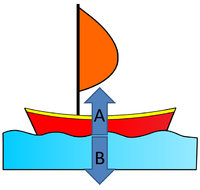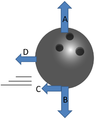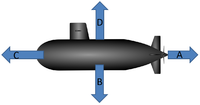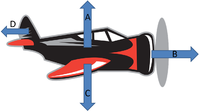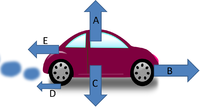Difference between revisions of "Force"
(→Meaning) |
|||
| Line 87: | Line 87: | ||
: E = [[Air Resistance]] | : E = [[Air Resistance]] | ||
|} | |} | ||
| + | |||
| + | ==Key Stage 3== | ||
| + | ===Meaning=== | ||
| + | A '''force''' is a [[vector]] quantity can affect the [[speed]], direction of motion or shape of an [[object]]. | ||
| + | |||
| + | ===About Forces=== | ||
| + | : The [[SI Unit]] of [[force]] is the [[Newton]] (N). | ||
| + | : [[Force]]s have [[magnitude]] and direction so they are [[vector]]s. | ||
| + | : A [[force]] can be [[measure]]d using a [[Newton Meter]]. | ||
| + | : [[Force]]s follow [[Newton's Third Law]] which states that if an [[object]] 'A' exerts a [[force]] on [[object]] 'B'; then [[object]] 'B' will exert a [[force]] on [[object]] 'A' which is equal in [[magnitude]] but opposite in direction to the original [[force]]. These are sometimes called an [[Action Force|action force]] and a [[Reaction Force|reaction force]]. This means when you push a wall with a [[force]] of 5N ([[Action Force]]), the wall pushes back with a [[force]] of 5N([[Reaction Force]]). If 'head' a football with a force of 10N then your head provides a [[force]] of 10N ([[Action Force]]) to the ball and the ball provides a [[force]] of 10N to your head ([[Reaction Force]]). | ||
| + | : [[Force]]s can cause an [[object]] to [[accelerate]]. | ||
| + | : A pair of opposing [[force]]s can twist, stretch or squash an [[object]]. This is known as [[deformation]]. | ||
Revision as of 20:46, 3 February 2019
Contents
Key Stage 2
Meaning
A force is something which can make an object; speed up, slow down or change shape.
- Noun: Force
About Forces
- A force can make an object speed up. When you let go of a pencil it will fall because a force called weight is making it speed up.
- A force can make an object slow down. When you roll a ball on the carpet it will slow down and stop because a force called friction has slowed it down.
- A force can change the shape of an object. When you tip a spoon of honey the honey will change shape and stretch because a force called weight pulls it into a long shape before dripping.
Key Stage 3
Meaning
A force is an influence that can change the speed, direction of motion or shape of an object.
About Forces
- The scientific units of force is the Newton (N). However, force can also be measured in pounds (lb) and ounces (Oz).
- Forces can be measured using a Newton Meter.
- Forces can be split into two groups, Contact Forces and Non-contact Forces.
| Contact Forces | Non-contact Forces |
- Forces can cause an object to accelerate.
- A pair of opposing forces can twist, stretch or squash an object. This is known as deformation.
Force Arrows
- Forces can be represented in a diagram with arrows that show the magnitude and direction of the force. A bigger arrow means a bigger force.
| A boat that is not moving. | A tennis ball falling. | A bowling ball moving to the right. |
|
| |
| A submarine travelling to the left. | A plane flying to the right. | A car driving to the right. |
|
|
|
Key Stage 3
Meaning
A force is a vector quantity can affect the speed, direction of motion or shape of an object.
About Forces
- The SI Unit of force is the Newton (N).
- Forces have magnitude and direction so they are vectors.
- A force can be measured using a Newton Meter.
- Forces follow Newton's Third Law which states that if an object 'A' exerts a force on object 'B'; then object 'B' will exert a force on object 'A' which is equal in magnitude but opposite in direction to the original force. These are sometimes called an action force and a reaction force. This means when you push a wall with a force of 5N (Action Force), the wall pushes back with a force of 5N(Reaction Force). If 'head' a football with a force of 10N then your head provides a force of 10N (Action Force) to the ball and the ball provides a force of 10N to your head (Reaction Force).
- Forces can cause an object to accelerate.
- A pair of opposing forces can twist, stretch or squash an object. This is known as deformation.
